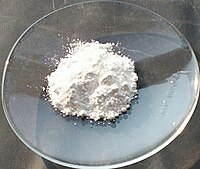
Photo from wikipedia
Abstract Lysozyme mediated zinc oxide nanoparticles (L:ZnO) synthesized by sol-gel method were characterized at room temperature using x-ray diffraction, scanning electron microscopy and absorption spectroscopy for structural, morphological and optical… Click to show full abstract
Abstract Lysozyme mediated zinc oxide nanoparticles (L:ZnO) synthesized by sol-gel method were characterized at room temperature using x-ray diffraction, scanning electron microscopy and absorption spectroscopy for structural, morphological and optical properties, respectively. A deep UV photoluminescence (PL) spectroscopy was employed to probe the optical transitions in the L:ZnO nanoparticles at low temperature (15 K). In the excitation power dependent PL measurements, we observed band edge emissions at 3.318, 3.359, and 3.374 eV due to recombination of a free electron from the conduction band to a hole in the acceptor level (FA), donor bound exciton (DoX) and free exciton (FX), respectively. A dominant emission peak around 2.40 eV is confirmed to be a donor acceptor pair (DAP) from the power dependent PL experiment. Based on the observed PL emission peaks, energy level diagram is constructed for the optical transitions in the L:ZnO particles and the DAP is assigned to the electronic transition from a deep donor level to the acceptor level related to the FA transition.
Journal Title: Optik
Year Published: 2020
Link to full text (if available)
Share on Social Media: Sign Up to like & get
recommendations!